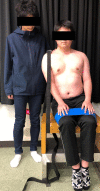The effects of vertical trunk supportability improvement on one-leg rebound jump efficiency
- PMID: 35588101
- PMCID: PMC9119522
- DOI: 10.1371/journal.pone.0267460
The effects of vertical trunk supportability improvement on one-leg rebound jump efficiency
Abstract
The purpose of this study was to examine the effects of vertical trunk supportability improvement on activities. The study participants were 36 people. Trunk function and physical performance were evaluated using the following tests: trunk righting test (TRT), maximal isometric knee extensor strength test, side hop test, triple hop distance test, stabilometry of one-leg standing, and one-leg rebound jump. The measurement was performed three times: pre-trunk training (pre), post-trunk training for 1 month (post), and 2 months after the second measurement (detraining). Details of trunk training: Two sets of 30-s maximal lateral reach exercises on each side, following the four sets of 15-s maximal raising trunk exercises on each side. The results with TRT in post-training were significantly larger than those in pre-and detraining. Similarly, the results with one-leg rebound jump efficiency in post-training were significantly larger than those in pre-and detraining. Our findings indicate that jump efficiency changes in proportion to the change in vertical trunk supportability.
Conflict of interest statement
The authors have declared that no competing interests exist.
Figures





Similar articles
-
Association of Hip and Trunk Strength With Three-Dimensional Trunk, Hip, and Knee Kinematics During a Single-Leg Drop Vertical Jump.J Strength Cond Res. 2018 Jul;32(7):1902-1908. doi: 10.1519/JSC.0000000000002564. J Strength Cond Res. 2018. PMID: 29528957
-
Reactive Strength Index and Knee Extension Strength Characteristics Are Predictive of Single-Leg Hop Performance After Anterior Cruciate Ligament Reconstruction.J Strength Cond Res. 2019 May;33(5):1201-1207. doi: 10.1519/JSC.0000000000003102. J Strength Cond Res. 2019. PMID: 30844991
-
Effect of Whole-Body-Vibration Training on Trunk-Muscle Strength and Physical Performance in Healthy Adults: Preliminary Results of a Randomized Controlled Trial.J Sport Rehabil. 2016 Dec;25(4):357-363. doi: 10.1123/jsr.2015-0022. Epub 2016 Aug 24. J Sport Rehabil. 2016. PMID: 27632856 Clinical Trial.
-
Trunk exercise training improves muscle size, strength, and function in older adults: A randomized controlled trial.Scand J Med Sci Sports. 2019 Jul;29(7):980-991. doi: 10.1111/sms.13415. Epub 2019 Apr 7. Scand J Med Sci Sports. 2019. PMID: 30859637 Clinical Trial.
-
The Effectiveness of Hollowing and Bracing Strategies With Lumbar Stabilization Exercise in Older Adult Women With Nonspecific Low Back Pain: A Quasi-Experimental Study on a Community-based Rehabilitation.J Manipulative Physiol Ther. 2018 Jan;41(1):1-9. doi: 10.1016/j.jmpt.2017.06.012. Epub 2017 Dec 16. J Manipulative Physiol Ther. 2018. PMID: 29254626 Review.
Cited by
-
Effects of Barefoot and Shod Conditions on the Kinematics and Kinetics of the Lower Extremities in Alternating Jump Rope Skipping-A One-Dimensional Statistical Parameter Mapping Study.Bioengineering (Basel). 2023 Oct 2;10(10):1154. doi: 10.3390/bioengineering10101154. Bioengineering (Basel). 2023. PMID: 37892884 Free PMC article.
-
Neuromuscular Electrical Stimulation Enhances Lower Limb Muscle Synergies During Jumping in Martial Artists Post-Anterior Cruciate Ligament Reconstruction: A Randomized Crossover Trial.Bioengineering (Basel). 2025 May 16;12(5):535. doi: 10.3390/bioengineering12050535. Bioengineering (Basel). 2025. PMID: 40428154 Free PMC article.
-
Potential Importance of Maximal Upper Body Strength-Generating Qualities and Upper Body Strength Training for Performance of High-Intensity Running and Jumping Actions: A Scoping Review.Sports (Basel). 2024 Dec 23;12(12):357. doi: 10.3390/sports12120357. Sports (Basel). 2024. PMID: 39728897 Free PMC article.
References
-
- Rickman AM, Ambegaonkar JP, Cortes N. Core stability: implications for dance injuries. Med Probl Perform Art. 2012; 27:159–164. - PubMed
MeSH terms
LinkOut - more resources
Full Text Sources

